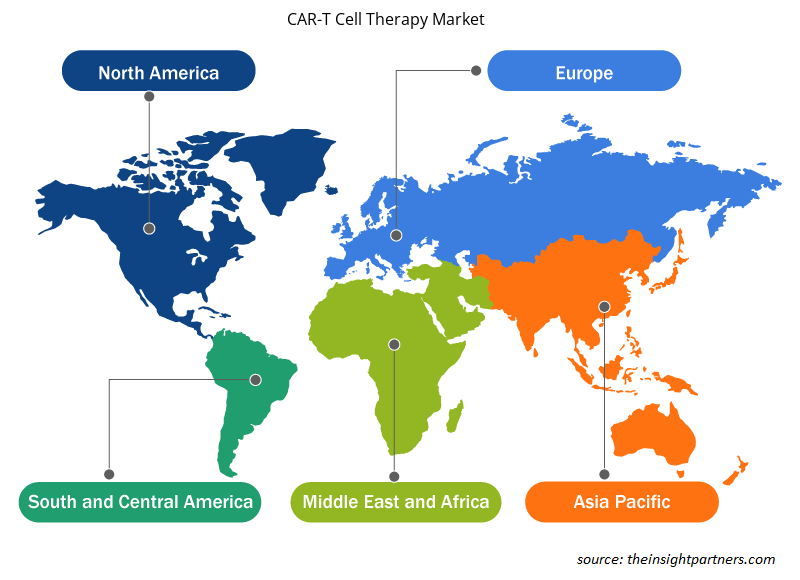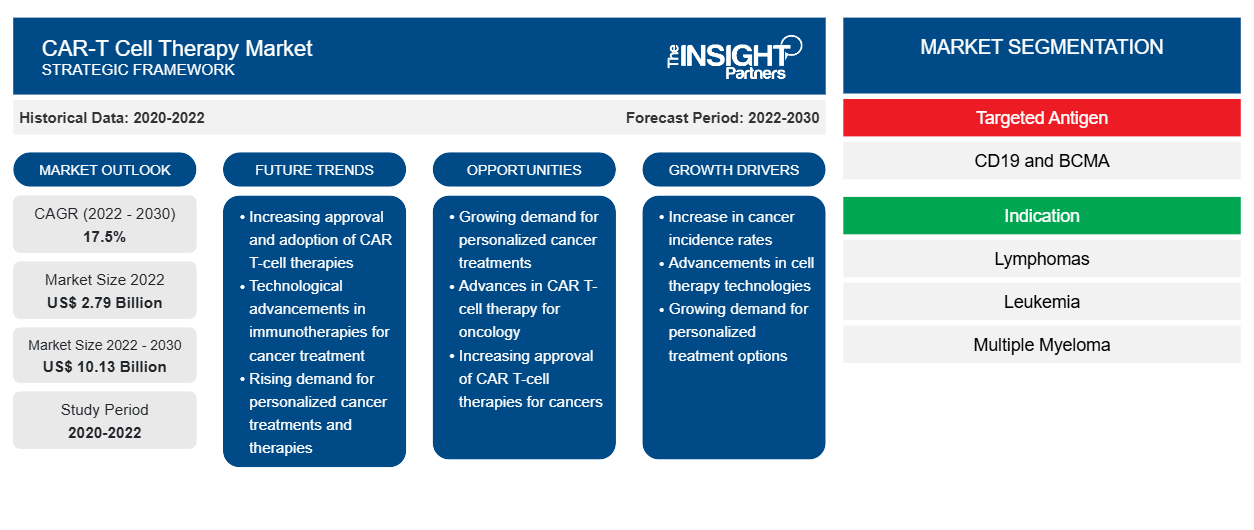[Forschungsbericht] Der Markt für CAR-T-Zelltherapien soll von 2,79 Milliarden US-Dollar im Jahr 2022 auf 10,13 Milliarden US-Dollar im Jahr 2030 anwachsen; für den Zeitraum 2022–2030 wird eine durchschnittliche jährliche Wachstumsrate (CAGR) von 17,5 % erwartet.
Markteinblicke und Analystenansichten:
Eine der vielversprechendsten Methoden zur Behandlung von Krebs ist die chimäre Antigenrezeptor-T-Zelltherapie (CAR). Jedes Jahr werden zahlreiche präklinische und klinische Studien durchgeführt, um ihre Anwendung zu erweitern. Nach Jahrzehnten der Forschung wird die CAR-T-Zelltherapie unweigerlich expandieren. Neben autologen und allogenen Produkten werden in Zukunft auch neue In-vivo-CAR-T-Zell-Gentherapien und die Wirksamkeit bei anderen Indikationen als hämatologischen Malignomen untersucht. Kommerzielle Herausforderungen behindern jedoch das Wachstum des CAR-T-Zelltherapiemarktes .
Wachstumstreiber:
Steigende Krebsprävalenz treibt den Markt für CAR-T-Zelltherapien an
Die CAR-T-Zelltherapie ist eine neue Krebsbehandlungsmethode. T-Zellen werden im Labor modifiziert und dann in den Körper zurückgeführt, um Krebszellen anzugreifen. Leukämie bei Erwachsenen und Kindern sowie einige Arten von Lymphomen werden mit der CAR-T-Zelltherapie behandelt. Darüber hinaus wird sie als mögliche Behandlungsmethode für andere Krebsarten erforscht, beispielsweise für einige solide Tumore, die sich im Brustkorb entwickeln.
Genetische Veranlagung, verarbeitete Lebensmittel, Umweltverschmutzung und veränderte Lebensstile sind die Faktoren, die zur Zunahme der Krebsprävalenz beitragen. Nach Angaben der American Cancer Society wurden im Jahr 2020 weltweit schätzungsweise 19,3 Millionen neue Krebsfälle registriert. Der Anstieg der Zahl der Krebspatienten treibt also die Nachfrage nach CAR-T-Zelltherapien an.
Passen Sie diesen Bericht Ihren Anforderungen an
Sie erhalten kostenlose Anpassungen an jedem Bericht, einschließlich Teilen dieses Berichts oder einer Analyse auf Länderebene, eines Excel-Datenpakets sowie tolle Angebote und Rabatte für Start-ups und Universitäten.
- Holen Sie sich die wichtigsten Markttrends aus diesem Bericht.Dieses KOSTENLOSE Beispiel umfasst eine Datenanalyse von Markttrends bis hin zu Schätzungen und Prognosen.
Berichtssegmentierung und -umfang:
Die „Marktanalyse für CAR-T-Zelltherapie“ wurde unter Berücksichtigung der folgenden Segmente durchgeführt: Zielantigen, Indikation und Endbenutzer.
Segmentanalyse:
Nach gezieltem Antigen ist der Markt für CAR-T-Zelltherapie in CD19 und BCMA segmentiert. Das CD19-Segment hatte 2022 einen größeren Marktanteil bei der CAR-T-Zelltherapie und wird im Prognosezeitraum voraussichtlich eine höhere CAGR von 17,9 % verzeichnen.
CAR-T-Zellen behandeln rezidiviertes/refraktäres diffuses großzelliges B-Zell-Lymphom wirksam. T-Zellen von Patienten werden genetisch modifiziert, um CD19-CAR-T-Zellen zu produzieren. Modifizierte T-Zellen exprimieren Rezeptoren, die an das hochexprimierte CD19-Protein binden, das in Leukämie- und Lymphomkrebszellen vorkommt.
Die Verfügbarkeit von CD19 CAR-T-Zelltherapieprodukten dürfte das Wachstum des Segments vorantreiben. Nachfolgend finden Sie die Liste der von der US-amerikanischen Food and Drug Administration und der Europäischen Union in den USA bzw. Europa zugelassenen Produkte:
Hersteller | Markenprodukt | Zielantigen | Krankheitsindikation | Genehmigungsjahr | |
Novartis | KYMRIAH | CD19 | Leukämie | 2017 | |
Gilead Sciences, Inc | JA, KARTE | CD19 | Lymphom | 2017 | |
Gilead Sciences, Inc | TECARTUS | CD19 | Lymphom und Leukämie | 2020 | |
Bristol Myers Squibb | BREYANZI | CD19 | Lymphom | 2021 |
Der Markt für CAR-T-Zelltherapien ist nach Indikation in Lymphome, Leukämie und Multiples Myelom unterteilt. Das Lymphomsegment hatte im Jahr 2022 einen größeren Marktanteil und wird im Prognosezeitraum voraussichtlich eine höhere CAGR von 18,1 % verzeichnen. Hämatologische Malignome wie akute lymphatische Leukämie, chronische lymphatische Leukämie , Lymphom und Multiples Myelom waren die Hauptindikationen für den Einsatz von CAR-T-Zellen.
Der Markt für CAR-T-Zelltherapien wird nach Endverbrauchern in Krankenhäuser und Fachkliniken, ambulante chirurgische Zentren und andere unterteilt. Das Segment Krankenhäuser und Fachkliniken hatte im Jahr 2022 den größten Marktanteil und wird im Prognosezeitraum voraussichtlich die höchste durchschnittliche jährliche Wachstumsrate von 17,9 % verzeichnen.
Technologische Fortschritte beschleunigen die Expansion des CAR-T-Zelltherapiemarktes
Die Entwicklung und Einführung der CAR-T-Therapie, bei der die weißen Blutkörperchen eines Patienten zur Bekämpfung bestimmter Formen von Blutkrebszellen eingesetzt werden, gehört zu den größten medizinischen Fortschritten der letzten Jahre. Einige Krebspatienten können in der CAR-T-Zelltherapie als potenzielle Heilung Hoffnung finden. Seit der Zulassung der ersten Therapie im Jahr 2017 wurden von der Food and Drug Administration (FDA) fünf weitere CAR-T-Zelltherapien zur Behandlung bestimmter Arten von Leukämie, Lymphomen und multiplem Myelom bei Erwachsenen und Kindern zugelassen. Es wird auch an der Entwicklung vergleichbarer Behandlungen für solide Tumorkrebsarten geforscht.
Die allogene CAR-T-Zelltherapie war Gegenstand hunderter präklinischer und klinischer Studien weltweit . Die meisten davon werden bei hämatologischen Malignomen eingesetzt, bei denen CD19 neben anderen traditionellen Zielen wie CD20, CD22 und BCMA das am häufigsten verwendete Ziel ist. Dazu gehören auch neu entwickelte Ziele wie CD70, CD7 und CD5. Zu den neuen Behandlungen für solide Tumore zählen Mesothelin, GD2 und NKG2DL.
Daher werden Fortschritte in der zellbasierten Therapie in den kommenden Jahren wahrscheinlich neue Trends auf dem Markt für CAR-T-Zelltherapien mit sich bringen.
Regionale Analyse:
Der Umfang des globalen Marktberichts zur CAR-T-Zelltherapie konzentriert sich auf Nordamerika, Europa, den asiatisch-pazifischen Raum, Süd- und Mittelamerika sowie den Rest der Welt. Im Jahr 2022 hatte Nordamerika den größten Marktanteil bei der CAR-T-Zelltherapie. Das Marktwachstum in dieser Region wird durch die zunehmende Zahl von Produkteinführungen wichtiger Hersteller und die Präsenz wichtiger Marktteilnehmer vorangetrieben. Darüber hinaus wird erwartet, dass umfangreiche F&E durch verschiedene Pharma- und Biotechnologieunternehmen sowie akademische und Forschungsinstitute das Marktwachstum in Nordamerika ankurbeln wird. So gab Bristol Myers Squibb im Juni 2022 bekannt, dass es die Zulassung von Breyanzi (Lisocabtagene Maraleucel), einer CD19-gerichteten CAR-T-Zelltherapie, von der US-amerikanischen Food and Drug Administration (FDA) zur Behandlung erwachsener Patienten mit großzelligem B-Zell-Lymphom (LBCL), einschließlich diffusem großzelligem B-Zell-Lymphom (DLBCL), erhalten hat.
In den USA wird das Wachstum des CAR-T-Zelltherapiemarktes hauptsächlich durch den wachsenden Pharma- und Biopharmasektor vorangetrieben , der sich durch technologische Fortschritte und zunehmende Flexibilität auszeichnet. Darüber hinaus stimulieren steigende F&E-Investitionen von US-amerikanischen Pharma- und Biotechnologieunternehmen zur Verbesserung der Ergebnisse klinischer Studien und Gewährleistung der Patientensicherheit das Marktwachstum. So wurde im Juli 2021 ein Kaufvertrag zwischen BioNTech SE und Kite, einem Gilead-Unternehmen, unterzeichnet, der es BioNTech ermöglicht, Kites klinische Produktionsanlage in Gaithersburg, MD, sowie seine F&E-Plattform für den Neoantigen-T-Zellrezeptor (TCR) für solide Tumoren zu erwerben. Der neue Standort in Gaithersburg ergänzt BioNTechs aktuelle Zelltherapie-Produktionsanlage in Idar-Oberstein, Deutschland, und bietet Produktionskapazitäten zur Stärkung klinischer Studien in den USA. Die Anlage trägt dazu bei, die wachsende Pipeline innovativer Zelltherapien des Unternehmens voranzutreiben, zu der Produktkandidaten für Krebs auf Basis von NEOSTIM und CAR-T Cell Amplifying mRNA Vaccine (CARVac) sowie das kürzlich erworbene Individualized Neoantigen TCR-Programm gehören.
Zukünftige Möglichkeiten und Forschung und Entwicklungen:
CAR-T-Zelltherapien haben vielversprechende Ergebnisse in der Krebsbehandlung gezeigt; ihre Anwendung ist jedoch auf Patienten mit bestimmten flüssigen Tumoren beschränkt, die rezidiviert und resistent sind. In den kommenden Jahren werden voraussichtlich mehrere CAR-T-Zelltherapien für die regenerative Medizin in den USA und Medizinprodukte für fortschrittliche Therapien in Europa die Marktzulassung erhalten. Hunderte verschiedener Hauptakteure entwickeln innovative Techniken für ein breites Spektrum an Indikationen. Auf lange Sicht können diese Behandlungen die Ergebnisse der Patienten verbessern, indem sie bereits mit einer einzigen Dosis erhebliche, sogar heilende gesundheitliche Vorteile bieten.
Die Zukunft der CAR-T-Zellbehandlung ist angesichts der Anzahl laufender klinischer Studien und der Entwicklung neuer CAR-T-Zellprodukte für eine Reihe von Indikationen recht vielversprechend. Forscher sind motiviert, nach Möglichkeiten zu suchen, die Wirksamkeit von CAR-T-Zellen zu verbessern, da bei Patienten mit rezidivierenden/refraktären Krebserkrankungen, die bereits viele Vorbehandlungen erhalten hatten, vollständige Ansprechraten und progressionsfreies Überleben beobachtet wurden.
Forscher untersuchen Elemente wie den Verlust von Antigenen, die zu einer Immunflucht führen könnten, und entwickeln Möglichkeiten, damit umzugehen. Eine solche Taktik ist die Entwicklung von CAR-T-Zellbehandlungen, die gleichzeitig auf mehrere Antigene abzielen. Es werden neue Medikamente entwickelt, die auf Antigene wie CD138 und GPRC5D abzielen. Im Gegensatz dazu zielen CAR-T-Zellbehandlungen für ALL und NHL auf das CD19-Antigen und Therapien für multiples Myelom auf das BCMA-Antigen.
Die Marktprognose für CAR-T-Zelltherapie kann den Beteiligten in diesem Markt bei der Planung ihrer Wachstumsstrategien helfen. Nachfolgend sind einige Forschungsergebnisse und Entwicklungen führender Akteure auf dem CAR-T-Zelltherapiemarkt aufgeführt:
- Im November 2023 gab Vittoria Biotherapeutics bekannt, dass es eine private Finanzierungsrunde abgeschlossen und dabei über 15 Millionen US-Dollar aufgebracht hat. Die Mittel werden für klinische Studien mit VIPER-101 verwendet – einer autologen dualpopulierten CD5-Knockout-CAR-T-Zellbehandlung für T-Zell-Lymphom.
- Im Dezember 2023 gab AstraZeneca die Übernahme von Gracell Biotechnologies Inc. bekannt, um die bestehenden Kapazitäten und früheren Investitionen von AstraZeneca in die Zelltherapie zu ergänzen.
- Im Dezember 2021 erhielten Forscher der University of California San Diego School of Medicine (USA) einen Zuschuss von 4,1 Millionen US-Dollar zur Unterstützung der Weiterentwicklung ihrer innovativen CAR-T-Zelltherapie. Die vom Verwaltungsrat des California Institute for Regenerative Medicine (USA) genehmigte Finanzierung könnte es der Gruppe ermöglichen, neuartige Krebsbehandlungen vom Labor ins Krankenbett zu bringen.
Regionale Einblicke in den CAR-T-Zelltherapiemarkt
Die regionalen Trends und Faktoren, die den Markt für CAR-T-Zelltherapien im Prognosezeitraum beeinflussen, wurden von den Analysten von Insight Partners ausführlich erläutert. In diesem Abschnitt werden auch die Marktsegmente und die Geografie der CAR-T-Zelltherapie in Nordamerika, Europa, im asiatisch-pazifischen Raum, im Nahen Osten und Afrika sowie in Süd- und Mittelamerika erörtert.

- Erhalten Sie regionalspezifische Daten zum CAR-T-Zelltherapiemarkt
Umfang des Marktberichts zur CAR-T-Zelltherapie
| Berichtsattribut | Details |
|---|---|
| Marktgröße im Jahr 2022 | 2,79 Milliarden US-Dollar |
| Marktgröße bis 2030 | 10,13 Milliarden US-Dollar |
| Globale CAGR (2022 - 2030) | 17,5 % |
| Historische Daten | 2020-2022 |
| Prognosezeitraum | 2022–2030 |
| Abgedeckte Segmente | Durch gezieltes Antigen
|
| Abgedeckte Regionen und Länder | Nordamerika
|
| Marktführer und wichtige Unternehmensprofile |
|
Dichte der Marktteilnehmer für CAR-T-Zelltherapie: Auswirkungen auf die Geschäftsdynamik verstehen
Der Markt für CAR-T-Zelltherapien wächst rasant, angetrieben durch die steigende Nachfrage der Endnutzer aufgrund von Faktoren wie sich entwickelnden Verbraucherpräferenzen, technologischen Fortschritten und einem größeren Bewusstsein für die Vorteile des Produkts. Mit steigender Nachfrage erweitern Unternehmen ihr Angebot, entwickeln Innovationen, um die Bedürfnisse der Verbraucher zu erfüllen, und nutzen neue Trends, was das Marktwachstum weiter ankurbelt.
Die Marktteilnehmerdichte bezieht sich auf die Verteilung der Firmen oder Unternehmen, die in einem bestimmten Markt oder einer bestimmten Branche tätig sind. Sie gibt an, wie viele Wettbewerber (Marktteilnehmer) in einem bestimmten Marktraum im Verhältnis zu seiner Größe oder seinem gesamten Marktwert präsent sind.
Die wichtigsten auf dem CAR-T-Zelltherapiemarkt tätigen Unternehmen sind:
- Bristol-Myers Squibb Company
- Novartis AG
- Gilead Sciences, Inc.
- Johnson & Johnson Services, Inc.
- CARsgenTherapeutics Co., Ltd
Haftungsausschluss : Die oben aufgeführten Unternehmen sind nicht in einer bestimmten Reihenfolge aufgeführt.

- Überblick über die wichtigsten Akteure auf dem CAR-T-Zelltherapiemarkt
Wettbewerbslandschaft und Schlüsselunternehmen:
Bristol-Myers Squibb Company; Novartis AG; Gilead Sciences, Inc.; Johnson & Johnson Services, Inc.; CARsgenTherapeutics Co., Ltd; Aurora Biopharma; Legend Biotech; Pfizer Inc.; bluebird bio, Inc.; Mustang Bio; Sorrento Therapeutics, Inc.; und Fate Therapeutics gehören zu den führenden Unternehmen, die im Marktbericht zur CAR-T-Zelltherapie vorgestellt werden. Diese Unternehmen konzentrieren sich auf die Entwicklung neuer Technologien, die Verbesserung bestehender Produkte und die Ausweitung ihrer geografischen Präsenz, um der wachsenden Verbrauchernachfrage weltweit gerecht zu werden.
- Historische Analyse (2 Jahre), Basisjahr, Prognose (7 Jahre) mit CAGR
- PEST- und SWOT-Analyse
- Marktgröße Wert/Volumen – Global, Regional, Land
- Branchen- und Wettbewerbslandschaft
- Excel-Datensatz
Aktuelle Berichte
Verwandte Berichte
Erfahrungsberichte
Grund zum Kauf
- Fundierte Entscheidungsfindung
- Marktdynamik verstehen
- Wettbewerbsanalyse
- Kundeneinblicke
- Marktprognosen
- Risikominimierung
- Strategische Planung
- Investitionsbegründung
- Identifizierung neuer Märkte
- Verbesserung von Marketingstrategien
- Steigerung der Betriebseffizienz
- Anpassung an regulatorische Trends





















 Kostenlose Probe anfordern für - Markt für CAR-T-Zelltherapie
Kostenlose Probe anfordern für - Markt für CAR-T-Zelltherapie